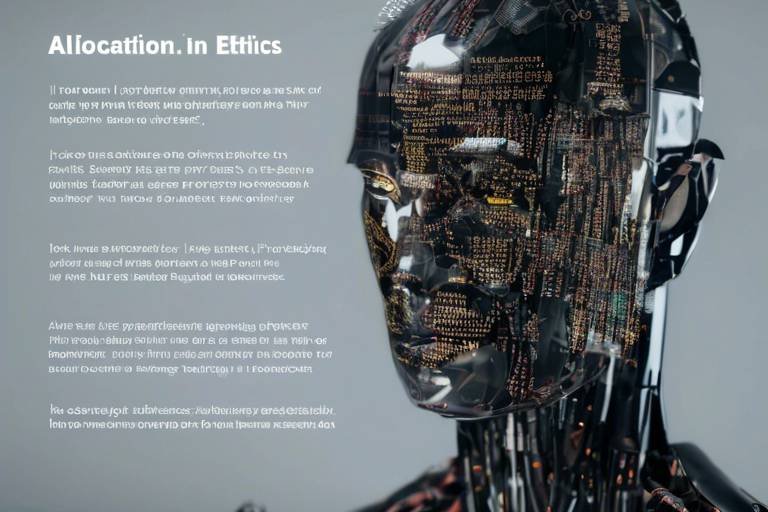AI Ethics: A Reality Check
As we plunge deeper into the digital age, the conversation surrounding AI ethics has never been more critical. Artificial Intelligence is not just a futuristic concept anymore; it is a reality that permeates various aspects of our daily lives—from the algorithms that power our social media feeds to the systems that assist in medical diagnoses. But with great power comes great responsibility, and this is where the ethical implications of AI come into play. Are we truly prepared for the consequences of deploying AI technology? Are we doing enough to ensure that it aligns with our societal values? These questions are not just rhetorical; they demand our urgent attention.
The rapid advancement of AI technologies raises a host of ethical dilemmas that we must navigate carefully. For instance, consider how AI systems can inadvertently perpetuate bias. If these systems are trained on flawed data, they can produce skewed results, affecting everything from hiring decisions to law enforcement practices. This reality check is essential for understanding the implications of AI on society. We need to recognize that the deployment of AI can lead to both incredible benefits and significant risks. Therefore, establishing a robust framework for ethical AI development is not just an option; it is a necessity.
Moreover, the lack of transparency in AI decision-making processes can lead to a crisis of trust. How can we hold systems accountable if we don't understand how they operate? This is why transparency is a cornerstone of ethical AI practices. It fosters trust between developers, users, and the broader community. In this article, we will explore the pressing issues surrounding AI ethics, examining the implications of AI technology on society, privacy, bias, and accountability. We will also look into best practices for ethical AI development to ensure that these technologies benefit humanity.
In the sections that follow, we will delve into fundamental ethical principles such as fairness, transparency, accountability, and privacy. These principles serve as guiding frameworks for the responsible development and implementation of AI technologies. By understanding these concepts, we can better navigate the complex landscape of AI ethics and work towards solutions that not only enhance technological innovation but also protect and empower individuals and communities.
- What is AI ethics? AI ethics refers to the moral principles and guidelines that govern the development and deployment of artificial intelligence technologies.
- Why is AI ethics important? AI ethics is crucial to ensure that AI technologies align with societal values and do not cause harm to individuals or communities.
- What are some key ethical principles in AI? Key principles include fairness, transparency, accountability, and privacy.
- How can bias in AI be addressed? Bias can be mitigated by improving data quality, employing fairness techniques, and regularly auditing AI systems.

The Importance of AI Ethics
Understanding the significance of AI ethics is crucial for developing technologies that align with societal values. As artificial intelligence continues to evolve and permeate various aspects of our lives, the ethical implications become increasingly complex. Imagine a world where machines make decisions that affect our daily lives—what happens when these decisions are biased, opaque, or harmful? This is where AI ethics steps in, acting as a compass guiding developers and organizations toward creating systems that benefit humanity while mitigating potential harms.
At its core, AI ethics encompasses the principles and values that should govern the development and deployment of AI technologies. By prioritizing ethical considerations, we can ensure that AI systems are not just efficient and effective, but also fair and trustworthy. This is especially important because AI systems are often integrated into critical sectors such as healthcare, finance, and law enforcement, where their impact can be profound. For instance, a biased AI tool in hiring could lead to discriminatory practices, undermining the very essence of equality and fairness.
Moreover, as we navigate through this technological landscape, it’s essential to foster a culture of accountability among AI developers and users. Who is responsible when an AI system makes a mistake? Is it the developer, the organization, or the AI itself? These questions are fundamental to establishing a framework where ethical considerations are at the forefront. Without accountability, we risk creating a future where AI operates without oversight, leading to unintended consequences that could harm individuals and society as a whole.
To further illustrate the importance of AI ethics, consider the following key points:
- Alignment with Societal Values: AI systems should reflect the values and norms of the societies they serve.
- Protection of Privacy: Ethical AI development must prioritize user privacy and data protection.
- Promotion of Fairness: Addressing and mitigating bias ensures equitable outcomes for all users.
In conclusion, the importance of AI ethics cannot be overstated. As we continue to innovate and integrate AI into our lives, we must remain vigilant in ensuring that these technologies serve the greater good. By embedding ethical considerations into the very fabric of AI development, we can pave the way for a future where technology enhances our lives without compromising our values.

Key Ethical Principles in AI
As we dive into the world of artificial intelligence, it's essential to recognize that the technology we create doesn't exist in a vacuum. AI ethics serves as a compass, guiding us through the complex landscape of technology and its impact on society. The key ethical principles in AI—fairness, transparency, accountability, and privacy—are not just buzzwords; they are the foundational blocks for building systems that are not only effective but also align with our collective values.
First up is fairness. In a world where AI systems are increasingly making decisions that affect our lives—from hiring processes to loan approvals—it's vital that these systems operate without bias. Imagine a world where a job applicant is overlooked not because of their qualifications but due to an algorithmic bias. That's a reality we need to prevent! To combat this, we must actively work towards creating algorithms that promote equitable outcomes for all individuals, regardless of their background.
Next, let's talk about transparency. This principle is all about making sure that the processes behind AI decisions are clear and understandable. If an AI system decides to reject your loan application, wouldn't you want to know why? Transparency fosters trust, and when users understand how decisions are made, they are more likely to accept the outcomes. Techniques such as explainable AI can help demystify the black box that often surrounds AI technologies, allowing for more informed users and stakeholders.
Then we have accountability. Who is responsible when an AI system goes awry? Establishing clear lines of accountability is crucial. It’s not just about pointing fingers when things go wrong; it's about creating a culture where developers and organizations take ownership of their AI systems. This leads to better practices and encourages innovation in a responsible manner. After all, accountability is the backbone of ethical AI development.
Finally, we must consider privacy. In an age where data is the new oil, protecting individual privacy is more important than ever. AI systems often rely on vast amounts of personal data to function effectively. However, this raises significant ethical questions about consent and data usage. Organizations need to prioritize data protection and ensure that users' privacy is safeguarded, creating a balance between leveraging data for AI advancements and respecting individual rights.
To sum it up, these principles are not just theoretical concepts; they are practical guidelines that can help shape the future of AI. By integrating fairness, transparency, accountability, and privacy into AI development, we can create systems that not only excel technologically but also resonate with the ethical standards of our society. As we move forward, it's crucial that we keep these principles at the forefront of AI innovation.
- What is AI ethics? AI ethics refers to the moral implications and responsibilities associated with the development and deployment of artificial intelligence technologies.
- Why is fairness important in AI? Fairness ensures that AI systems do not discriminate against individuals based on race, gender, or other attributes, promoting equitable treatment for all.
- How can transparency be achieved in AI systems? Transparency can be achieved through explainable AI techniques that provide insights into how decisions are made by algorithms.
- What does accountability mean in the context of AI? Accountability involves establishing clear responsibility for AI decisions and outcomes, ensuring that developers and organizations are held to ethical standards.
- How do we protect privacy in AI? Protecting privacy in AI requires implementing strong data protection measures and ensuring that individuals have control over their personal information.

Fairness and Bias in AI
In the realm of artificial intelligence, fairness and bias are not just buzzwords; they are critical components that can determine the success or failure of AI systems. Imagine a world where your job application is evaluated by an algorithm that has been trained on biased data. This could lead to unfair rejections based purely on historical biases rather than your qualifications. In essence, addressing bias in AI is not merely a technical challenge but a moral imperative. When we talk about fairness in AI, we are essentially discussing the equitable treatment of all individuals, regardless of their background, gender, or ethnicity. This is increasingly important as AI technologies become more embedded in our lives, influencing decisions in hiring, law enforcement, healthcare, and beyond.
Bias in AI can stem from various sources, including training data, algorithm design, and even the societal norms that inform these systems. For instance, if an AI model is trained on historical data that reflects past discrimination, it may inadvertently perpetuate these biases. This is why understanding the sources of bias is crucial. Some common sources include:
- Historical Bias: Data reflecting societal inequalities.
- Sampling Bias: Non-representative data samples.
- Label Bias: Mislabeling or subjective labeling of data.
To combat these challenges, various strategies can be employed. One effective approach is to enhance the quality of training data. By ensuring that the data is representative of the diverse population it serves, we can reduce the likelihood of biased outcomes. Moreover, techniques such as adversarial debiasing can be employed to adjust the model during training, making it less sensitive to biased inputs. This method essentially introduces a counteracting force to the bias, helping to create a more balanced algorithm.
As we delve deeper into the realm of AI, it becomes increasingly clear that fairness is not a one-time fix but an ongoing commitment. Organizations must continuously monitor their AI systems and be willing to adapt as societal norms evolve. The journey towards fairness in AI is akin to navigating a ship through turbulent waters; it requires vigilance, adaptability, and a steadfast commitment to ethical principles.
In summary, ensuring fairness in AI systems is a multifaceted challenge that requires a comprehensive understanding of bias, a commitment to high-quality data, and the application of advanced techniques to mitigate these issues. As we look to the future, the question remains: how can we ensure that AI serves as a force for good in our society, rather than perpetuating existing inequalities?
- What is AI bias? AI bias refers to the systematic and unfair discrimination that can occur in AI systems due to biased training data or flawed algorithms.
- How can we identify bias in AI systems? Bias can be identified through rigorous testing and evaluation of AI models, including analyzing outcomes across different demographic groups.
- What are some methods to promote fairness in AI? Techniques such as adversarial debiasing, fairness constraints, and improving data quality can help promote fairness in AI systems.

Identifying Bias in Data
When it comes to artificial intelligence, the data we use is like the foundation of a house. If the foundation is flawed, the entire structure is at risk of collapsing. Identifying bias in data is crucial for creating fair and reliable AI models. Bias can creep into data from various sources, including historical inequalities, societal stereotypes, and even the way data is collected. For instance, if a dataset primarily consists of information from a specific demographic, the AI trained on that data may not perform well for underrepresented groups. This can lead to decisions that are not only unfair but potentially harmful.
One of the first steps in identifying bias is to conduct a thorough data audit. This involves examining the data for any signs of imbalance or skew. Some questions to consider during this audit include:
- Is the data representative of the population it is meant to serve?
- Are there any missing groups that should be included?
- How were the data points collected, and could that process introduce bias?
Moreover, employing statistical techniques can help to uncover hidden biases. For example, you might use descriptive statistics to analyze the distribution of different demographic groups within your dataset. Visualizations, such as histograms or box plots, can also be beneficial in spotting anomalies that may indicate bias. By utilizing these methods, organizations can gain a clearer picture of their data's integrity.
Another effective strategy is to engage in community feedback. Involving diverse stakeholders in the data evaluation process can provide insights that may not be apparent through quantitative analysis alone. Those with lived experiences can highlight potential biases and suggest ways to mitigate them, ensuring that the AI system is designed with inclusivity in mind.
Ultimately, identifying bias in data is not a one-time task; it requires ongoing vigilance and a commitment to improvement. By continuously monitoring and refining datasets, organizations can work towards building AI systems that not only perform well but also uphold the principles of equity and justice.
- What is data bias? Data bias refers to systematic errors in data that can lead to unfair or inaccurate outcomes in AI models.
- How can I identify bias in my dataset? Conduct a data audit, use statistical techniques, and seek community feedback to uncover potential biases.
- Why is it important to address bias in AI? Addressing bias is crucial for ensuring that AI systems are fair, equitable, and beneficial for all users.
- Can bias in data be completely eliminated? While it may be challenging to eliminate bias entirely, ongoing monitoring and refinement can significantly reduce its impact.

Algorithmic Fairness Techniques
When we talk about algorithmic fairness, we're diving into a realm that's both fascinating and critical for the future of technology. The idea is to ensure that AI systems treat all individuals equally, without bias or discrimination. But how do we achieve this? There are several techniques that developers and researchers employ to enhance fairness in AI algorithms. Let’s break down some of the most effective methods.
One prominent approach is adversarial debiasing. This technique involves training a model to not only predict outcomes but also to minimize the influence of biased data. Imagine a referee in a sports game who is trained to overlook any unfair advantages a player might have; similarly, adversarial debiasing helps AI systems focus on the relevant features while ignoring those that could lead to biased decisions. By using a two-pronged approach where one model attempts to predict outcomes while another tries to detect bias, developers can refine their systems to promote fairness.
Another method worth mentioning is the use of fairness constraints during model training. This technique sets specific guidelines that the algorithm must adhere to in order to ensure equitable treatment across different demographic groups. For instance, if an AI system is being trained to approve loan applications, fairness constraints would ensure that the approval rates are similar across various racial and gender groups. It’s like setting up a level playing field where everyone has an equal chance to succeed, regardless of their background.
Additionally, pre-processing and post-processing techniques can be employed to adjust the data before it’s fed into the algorithm or to modify the output after predictions have been made. Pre-processing might involve altering the training dataset to remove biased samples, while post-processing could include adjusting the final predictions to meet fairness criteria. Think of it like editing a movie; sometimes, you need to cut out scenes that don’t fit the narrative you want to tell.
To give you a clearer picture, here’s a simple table summarizing these techniques:
| Technique | Description |
|---|---|
| Adversarial Debiasing | Uses two models to minimize bias in predictions. |
| Fairness Constraints | Sets guidelines during training to ensure equitable outcomes. |
| Pre-processing | Alters the training data to remove bias before training. |
| Post-processing | Modifies predictions to meet fairness standards after training. |
Implementing these techniques is not just a matter of compliance; it’s about fostering trust and integrity in AI systems. After all, if people perceive AI as fair, they are more likely to embrace it in their daily lives. As we continue to innovate and develop new technologies, the importance of algorithmic fairness cannot be overstated. It’s not merely a checkbox to tick off; it’s a commitment to creating a just and equitable society.
- What is algorithmic fairness? Algorithmic fairness refers to the principle that AI systems should operate without bias, ensuring equitable treatment for all individuals.
- Why is fairness important in AI? Fairness is crucial because biased AI can lead to unfair treatment of individuals, perpetuating existing inequalities in society.
- How can bias be detected in AI systems? Bias can be detected through various methods, including statistical analysis of outcomes and auditing the training data for imbalances.
- What role do regulations play in AI fairness? Regulations can help establish standards and guidelines that organizations must follow to ensure their AI systems are fair and accountable.

The Role of Transparency
In today's rapidly evolving world of artificial intelligence, transparency has become a cornerstone of ethical AI development. Imagine you're driving a car, but the dashboard is completely opaque; you can't see your speed, fuel level, or even if the engine is overheating. That's what it feels like when AI systems operate in a black box. Transparency allows users and stakeholders to understand how AI systems make decisions, fostering a sense of trust and accountability. When AI is transparent, it’s like having a clear windshield; you can see where you're going, which is crucial for navigating the complexities of modern technology.
One of the main reasons transparency is vital in AI is that it helps to demystify the algorithms that power these systems. Many people are understandably skeptical about AI, often fearing that these technologies could lead to biased or unfair outcomes. By being open about how AI models work, developers can alleviate these concerns. For instance, when an AI system makes a decision—say, denying a loan or selecting a candidate for a job—transparency ensures that the criteria used are visible and understandable. This is not just about providing a rationale; it’s about building a bridge of trust between technology and society.
Moreover, transparency enhances accountability in AI development. When the inner workings of AI systems are clear, it becomes easier to identify who is responsible for any adverse outcomes. This could be the developers, the data scientists, or even the organizations that deploy these systems. Without transparency, accountability becomes murky, leading to a culture of blame-shifting rather than problem-solving. Just as you wouldn't want to invest in a company with hidden practices, consumers and stakeholders should demand transparency in AI technologies to ensure ethical practices.
Achieving transparency in AI isn’t merely about revealing algorithms or data sources; it also involves making the technology understandable to non-experts. This means employing explainable AI (XAI) techniques, which aim to provide insights into how AI systems arrive at their conclusions. For example, if an AI model predicts that a patient has a high risk of a certain disease, it should be able to explain the factors contributing to that prediction. This not only helps healthcare professionals make informed decisions but also empowers patients to understand their health better.
To summarize, transparency in AI is not just a nice-to-have; it’s an essential component for ethical development and deployment. It builds trust, enhances accountability, and allows for informed decision-making. As we move forward, it’s imperative for developers and organizations to prioritize transparency in their AI initiatives. The more we can see and understand how AI systems operate, the better equipped we will be to harness their potential for good while mitigating risks.
Frequently Asked Questions
- What is transparency in AI? Transparency in AI refers to the clarity and openness regarding how AI systems operate, including the algorithms used and the data they rely on.
- Why is transparency important? Transparency is crucial for building trust, ensuring accountability, and enabling users to understand the decision-making processes of AI systems.
- How can organizations improve transparency in their AI systems? Organizations can improve transparency by adopting explainable AI techniques, providing clear documentation, and engaging stakeholders in discussions about AI use.

Accountability in AI Development
Establishing accountability in AI development is not just a buzzword; it's a crucial aspect that can shape the future of technology and its impact on society. As AI systems become increasingly integrated into our daily lives, the question of who is responsible for the decisions made by these systems becomes ever more pressing. Imagine a world where autonomous vehicles make decisions that could harm pedestrians or where AI-driven hiring algorithms unfairly filter out qualified candidates based on biased data. In such scenarios, identifying who is accountable is essential to ensure justice and maintain public trust.
One of the fundamental challenges in AI accountability is the complexity of these systems. Unlike traditional software, AI models often operate as "black boxes," making it difficult to trace their decision-making processes. This opacity can lead to a lack of trust among users and stakeholders, as they may feel powerless to challenge or understand the outcomes produced by AI. Therefore, it is imperative to implement mechanisms that can provide clarity and insight into how AI systems function and the rationale behind their decisions.
Accountability in AI can take various forms, including:
- Legal Accountability: This involves establishing laws and regulations that define the responsibilities of AI developers and users. For instance, if an AI system causes harm, legal frameworks should clarify who can be held liable.
- Organizational Accountability: Companies developing AI technologies must create internal policies that promote ethical practices. This could involve appointing ethics officers or forming committees dedicated to overseeing AI projects.
- Social Accountability: The broader community, including consumers and advocacy groups, plays a role in holding companies accountable. Public scrutiny can drive organizations to adopt better practices and improve the ethical standards of their AI systems.
To further enhance accountability, the development of clear legal and regulatory frameworks is essential. Current regulations often lag behind technological advancements, leaving gaps that can be exploited. Policymakers must work collaboratively with technologists, ethicists, and the public to create comprehensive guidelines that govern AI technologies. This includes addressing issues such as data privacy, algorithmic bias, and the ethical use of AI in sensitive areas like healthcare and law enforcement.
Moreover, accountability also extends to the innovation process. Organizations must balance the drive for innovation with ethical considerations. Rapid advancements in AI can lead to unintended consequences, and without a framework for accountability, these developments can spiral out of control. Encouraging a culture of ethical innovation can help mitigate risks and ensure that AI serves the greater good.
In conclusion, accountability in AI development is not just about assigning blame when things go wrong; it's about fostering a culture of responsibility that permeates every stage of AI creation and deployment. By establishing robust accountability mechanisms and promoting transparency, we can build trust in AI technologies and ensure they are developed and used ethically.

Legal and Regulatory Frameworks
In the rapidly evolving world of artificial intelligence, establishing is not just important; it's imperative. As AI technologies become more integrated into our daily lives, the questions surrounding their governance grow increasingly complex. Who is responsible when an AI system makes a mistake? What happens when an algorithm discriminates against a group of people? These are the pressing issues that demand clear legal guidelines and regulations.
Currently, many countries are grappling with how to create effective regulations that balance innovation with ethical considerations. A variety of approaches are being explored, from comprehensive national strategies to localized regulations targeting specific applications of AI. For instance, the European Union has proposed a regulatory framework that seeks to categorize AI applications based on risk levels, imposing stricter regulations on high-risk systems. This is a significant step towards ensuring that AI technologies are developed and deployed responsibly.
To better understand the landscape, let's take a look at some existing legal frameworks around the world:
| Region | Framework | Key Features |
|---|---|---|
| European Union | AI Act (Proposed) | Risk-based classification, strict guidelines for high-risk AI applications |
| United States | AI Bill of Rights (Proposed) | Guidelines for the ethical use of AI, focusing on privacy and civil rights |
| China | New Generation AI Development Plan | Focus on national security and social stability, promoting AI innovation |
Beyond these frameworks, many organizations are recognizing the need for self-regulation and ethical guidelines. Industry leaders are beginning to adopt best practices that not only comply with existing regulations but also set higher standards for ethical AI development. This is crucial because while regulations can provide a baseline, true accountability often comes from within the industry itself.
Moreover, the role of international cooperation cannot be understated. AI is a global phenomenon, and its implications cross borders. Countries must work together to establish common standards and practices that promote ethical AI development worldwide. This is where organizations like the United Nations and the OECD can play pivotal roles in fostering dialogue and collaboration among nations.
In conclusion, the establishment of robust legal and regulatory frameworks is essential for the ethical development of AI technologies. As we navigate this complex landscape, it is crucial to remain vigilant about the implications of AI on society, ensuring that the benefits of these advancements are realized while minimizing potential harms.
- What is the purpose of AI regulations? AI regulations aim to ensure that AI technologies are developed and used ethically, protecting individuals' rights and promoting public trust.
- How do different countries approach AI regulation? Countries vary in their approaches, with some proposing comprehensive laws while others focus on specific applications or ethical guidelines.
- Why is international cooperation important in AI regulation? AI technologies often transcend borders, making it essential for countries to collaborate on common standards to ensure global ethical practices.

Industry Best Practices
In the rapidly evolving landscape of artificial intelligence, adhering to industry best practices is not just beneficial; it’s essential for fostering ethical AI development. Organizations that prioritize ethical considerations in their AI initiatives are better positioned to build trust with users and stakeholders. But what exactly does this entail? It involves a comprehensive approach that encompasses technical, operational, and cultural dimensions.
One of the key practices is to establish a diverse development team. A team composed of individuals with varied backgrounds, perspectives, and experiences is crucial for identifying and mitigating biases that can inadvertently seep into AI systems. When teams reflect the diversity of the user base, they are more likely to create solutions that cater to a wider audience, thus enhancing fairness and equity.
Moreover, implementing rigorous testing and validation protocols is vital. This means not only testing algorithms for accuracy but also scrutinizing them for potential biases. Organizations should adopt a continuous feedback loop where AI systems are regularly evaluated against real-world scenarios. This proactive approach helps in identifying issues before they escalate into larger ethical dilemmas.
Another best practice involves maintaining transparency with users. Companies should strive to provide clear, understandable explanations of how their AI systems work and the decisions they make. This transparency fosters trust and allows users to make informed choices. For example, if a user is denied a loan based on an AI assessment, they should be able to understand the factors that influenced that decision.
To facilitate these practices, organizations can benefit from establishing an AI ethics committee. This committee, composed of cross-functional stakeholders, can oversee AI projects, ensuring they align with ethical standards and societal values. Such committees can also serve as a platform for discussing ethical dilemmas and providing guidance on best practices.
In addition, organizations should consider adopting industry-wide standards and frameworks. For instance, frameworks like the AI Ethics Guidelines from the European Commission provide a solid foundation for ethical AI practices. By aligning with these guidelines, companies can ensure they are meeting not only legal requirements but also ethical expectations from society.
Lastly, ongoing education and training are paramount. As AI technology evolves, so too should the knowledge and skills of those working with it. Organizations should invest in regular training sessions that focus on ethical implications, bias detection, and the importance of transparency in AI systems. This commitment to education is crucial for fostering a culture of ethics within the organization.
By embracing these industry best practices, organizations can significantly enhance their approach to ethical AI development. The road to ethical AI is not without its challenges, but with a concerted effort towards implementing these practices, the potential for positive impact on society is immense.
- What are the main ethical concerns surrounding AI? Ethical concerns include bias in decision-making, lack of transparency, and accountability for AI-driven outcomes.
- How can organizations ensure fairness in AI? By diversifying development teams, implementing rigorous testing, and establishing clear guidelines for ethical AI practices.
- What role does transparency play in AI ethics? Transparency fosters trust and allows users to understand how AI systems make decisions, thus promoting accountability.
- Are there existing frameworks for ethical AI? Yes, frameworks such as the AI Ethics Guidelines from the European Commission provide guidelines for ethical AI practices.
Frequently Asked Questions
- What is AI ethics and why is it important?
AI ethics refers to the moral implications and responsibilities associated with the development and deployment of artificial intelligence technologies. It's crucial because these technologies can significantly impact society, privacy, and individual rights. By ensuring that AI aligns with societal values, we can harness its benefits while minimizing potential harms.
- What are the key ethical principles in AI?
The fundamental ethical principles in AI include fairness, transparency, accountability, and privacy. These principles guide developers and organizations in creating AI systems that are responsible and beneficial to society. By adhering to these principles, we can work towards equitable and trustworthy AI solutions.
- How can bias in AI systems be addressed?
Addressing bias in AI systems involves recognizing and mitigating biases present in training data and algorithms. Techniques such as data auditing, adversarial debiasing, and implementing fairness constraints during model training can help ensure that AI systems produce equitable outcomes for all users.
- Why is transparency important in AI development?
Transparency is vital because it fosters trust between AI systems and their users. When AI decisions are explainable, users are more likely to understand and accept them. This accountability not only enhances user confidence but also encourages responsible innovation in AI technologies.
- Who is responsible for AI decisions?
Establishing accountability in AI development is complex, as multiple stakeholders can be involved, including developers, organizations, and even policymakers. It's essential to define clear lines of responsibility to address ethical concerns and ensure that AI technologies are used responsibly and ethically.
- What legal frameworks exist to govern AI technologies?
Currently, various regulations and guidelines are being developed to govern AI technologies, focusing on ethical practices and accountability. These frameworks aim to ensure that AI systems are designed and implemented in ways that respect individual rights and promote societal welfare.
- What are some industry best practices for ethical AI?
Industry best practices for ethical AI include conducting thorough impact assessments, engaging diverse teams in the development process, and following established guidelines for fairness and transparency. Successful case studies show that organizations adopting these practices can achieve better outcomes and foster public trust in their AI initiatives.



















